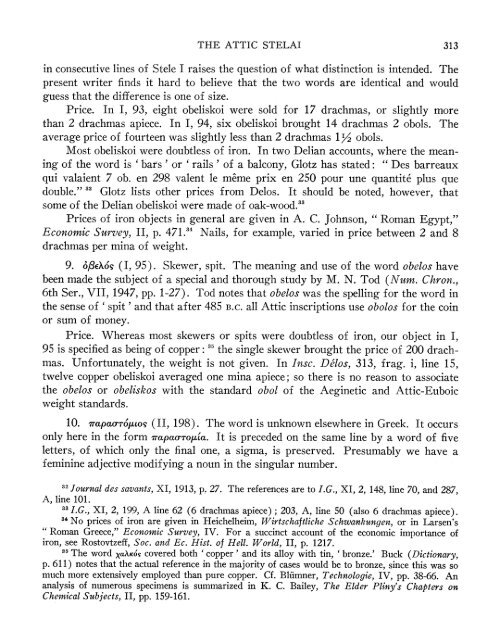the attic stelai - The American School of Classical Studies at Athens
the attic stelai - The American School of Classical Studies at Athens
the attic stelai - The American School of Classical Studies at Athens
Create successful ePaper yourself
Turn your PDF publications into a flip-book with our unique Google optimized e-Paper software.
THE ATTIC STELAI 313<br />
in consecutive lines <strong>of</strong> Stele I raises <strong>the</strong> question <strong>of</strong> wh<strong>at</strong> distinction is intended. <strong>The</strong><br />
present writer finds it hard to believe th<strong>at</strong> <strong>the</strong> two words are identical and would<br />
guess th<strong>at</strong> <strong>the</strong> difference is one <strong>of</strong> size.<br />
Price. In I, 93, eight obeliskoi were sold for 17 drachrnas, or slightly more<br />
than 2 drachmas apiece. In I, 94, six obeliskoi brought 14 drachmas 2 obols. <strong>The</strong><br />
average price <strong>of</strong> fourteen was slightly less than 2 drachmas 1X2 obols.<br />
Most obeliskoi were doubtless <strong>of</strong> iron. In two Delian accounts, where <strong>the</strong> meaning<br />
<strong>of</strong> <strong>the</strong> word is 'bars' or 'rails ' <strong>of</strong> a balcony, Glotz has st<strong>at</strong>ed: " Des barreaux<br />
qui valaient 7 ob. en 298 valent le meme prix en 250 pour une quantite plus que<br />
double." 32 Glotz lists o<strong>the</strong>r prices from Delos. It should be noted, however, th<strong>at</strong><br />
some <strong>of</strong> <strong>the</strong> Delian obeliskoi were made <strong>of</strong> oak-wood.33<br />
Prices <strong>of</strong> iron objects in general are given in A. C. Johnson, " Roman Egypt,"<br />
Economic Survey, II, p. 471.34 Nails, for example, varied in price between 2 and 8<br />
drachmas per mina <strong>of</strong> weight.<br />
9. o,/EXo6 (I, 95). Skewer, spit. <strong>The</strong> meaning and use <strong>of</strong> <strong>the</strong> word obelos have<br />
been made <strong>the</strong> subject <strong>of</strong> a special and thorough study by M. N. Tod (Num. Chron.,<br />
6th Ser., VII, 1947, pp. 1-27). Tod notes th<strong>at</strong> obelos was <strong>the</strong> spelling for <strong>the</strong> word in<br />
<strong>the</strong> sense <strong>of</strong> 'spit ' and th<strong>at</strong> after 485 B.C. all Attic inscriptions use obolos for <strong>the</strong> coin<br />
or sum <strong>of</strong> money.<br />
Price. Whereas most skewers or spits were doubtless <strong>of</strong> iron, our object in I,<br />
95 is specified as being <strong>of</strong> copper: " <strong>the</strong> single skewer brought <strong>the</strong> price <strong>of</strong> 200 drachmas.<br />
Unfortun<strong>at</strong>ely, <strong>the</strong> weight is not given. In Insc. Delos, 313, frag. i, line 15<br />
twelve copper obeliskoi averaged one mina apiece; so <strong>the</strong>re is no reason to associ<strong>at</strong>e<br />
<strong>the</strong> obelos or obeliskos with <strong>the</strong> standard obol <strong>of</strong> <strong>the</strong> Aeginetic and Attic-Euboic<br />
weight standards.<br />
10. vrapac-ro1uto (II, 198). <strong>The</strong> word is unknown elsewhere in Greek. It occurs<br />
only here in <strong>the</strong> form 7rapao-ropta. It is preceded on <strong>the</strong> same line by a word <strong>of</strong> five<br />
letters, <strong>of</strong> which only <strong>the</strong> final one, a sigma, is preserved. Presumably we have a<br />
feminine adjective modifying a noun in <strong>the</strong> singular number.<br />
32<br />
Journal des savants, XI, 1913, p. 27. <strong>The</strong> references are to I.G., XI, 2, 148, line 70, and 287,<br />
A, line 101.<br />
33 I.G., XI, 2, 199, A line 62 (6 drachmas apiece); 203, A, line 50 (also 6 drachmas apiece).<br />
34 No prices <strong>of</strong> iron are given in Heichelheim, Wirtschaftliche Schwankungen, or in Larsen's<br />
Roman Greece," Economic Survey, IV. For a succinct account <strong>of</strong> <strong>the</strong> economic importance <strong>of</strong><br />
iron, see Rostovtzeff, Soc. and Ec. Ilist. <strong>of</strong> Hell. World, II, p. 1217.<br />
35 <strong>The</strong> word xaAKro covered both 'copper' and its alloy with tin, 'bronze.' Buck (Dictionary,<br />
p. 611) notes th<strong>at</strong> <strong>the</strong> actual reference in <strong>the</strong> majority <strong>of</strong> cases would be to bronze, since this was so<br />
much more extensively employed than pure copper. Cf. Bliimner, Technologie, IV, pp. 38-66. An<br />
analysis <strong>of</strong> numerous specimens is summarized in K. C. Bailey, <strong>The</strong> Elder Pliny's Chapters on<br />
Chemical Subjects, II, pp. 159-161.
















